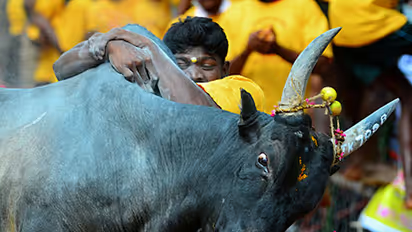Jallikattu is not only a sport, it has a scientific reason!

Synopsis
Does Jallikattu really have a scientific reason to be conducted? What has Jallikattu to do with insemination The seals used in the Indus valley civilisation, 5000 years ago also depict Jallikattu
As Pongal is nearing the Tamilans demand to lift the ban on Jallikattu (bull fighting) conducted during the festival has reached its peak. From top actors like Kamal Hassan to popular actor Dhanush, Siva Karthikeyan and others have supported Jallikattu. All they are saying is it is a part of Tamil tradition.
Is the sport being part of their tradition the only truth or there is anything more to the sport? It has a scientific reason too, say the pages of Tamil history.
Also Read: Is the SC view on Jallikattu an indication of its mind on Sabarimala?
Tamil Nadu is an agriculture-based land; cows and buffaloes are the vital part of every Tamil family, at least living in the rural areas. Why would the family which otherwise loves the animal just like a family member, push the bull for a fighting?
For this you need to know the rules and origin of bull fighting. The sport was originally called as ‘Eru Thazhuvuthal’ which meant bull embracing.
Also Read: ‘Jayalalithaa to be blamed for jallikattu ban’
The sport served two main purposes. It was conducted by or sometimes for girls to find a suitable boy for marriage. The man who wins the bull fight was considered suitable for the girl and all others who failed in the sport were rejected.
But scientifically, Jallikattu was being conducted to find out which bull was the strongest. Then the one (bull) which wins the fight was used for insemination. The belief was that the offspring of the strong bull and the strong cow will be strong as well. This was also known to help in getting quality milk.
This was the way the people in rural areas protected the native breeds of bulls and cows. The bull which is used for the fight is given special food and taken care of. It is considered as a member of the family.
Also Read: The power of Tamil superstars back up Jallikattu support
Originally the sport stayed true to its term ‘Eru Thazhuvuthal’ and people had to control the bull just by embracing the hump on its body.
Thus, getting quality milk and protecting the native breeds of the bulls and cows was the main reason for conducting Jallikattu.
Jallikattu was originally known as Salli Kattu (Salli measn coins and Kattu is a package) Sallikattu was a game where people had to fight the bull and get the package of coin tied to the horns of the bull. As years passed the game was called Jallikattu.
Moreover, going by the pages of the history, it is also known as an ancient sport being conducted from 5,000 years. The seals used in the Indus valley civilisation also depict Jallikattu. It is also mentioned in the ancient Tamil poetry Sangam literature written during 2nd BC. There are many references to its original term Eru Thazhuvuthal.
Isn’t there a need to protect the native breeds of animals? But is Jallikattu the only way to do so?